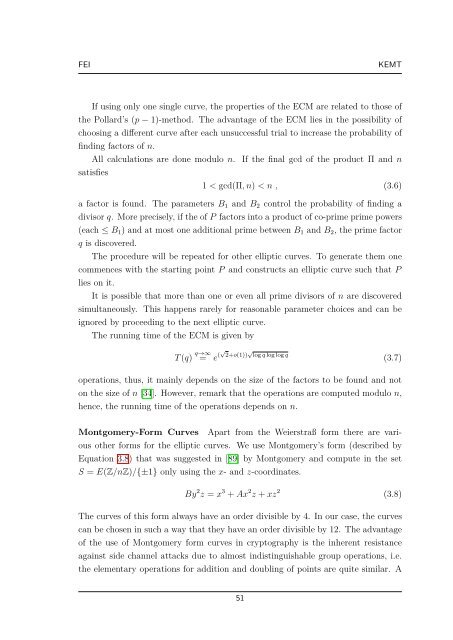1 Montgomery Modular Multiplication in Hard- ware
1 Montgomery Modular Multiplication in Hard- ware
1 Montgomery Modular Multiplication in Hard- ware
You also want an ePaper? Increase the reach of your titles
YUMPU automatically turns print PDFs into web optimized ePapers that Google loves.
FEI KEMT<br />
If us<strong>in</strong>g only one s<strong>in</strong>gle curve, the properties of the ECM are related to those of<br />
the Pollard’s (p − 1)-method. The advantage of the ECM lies <strong>in</strong> the possibility of<br />
choos<strong>in</strong>g a different curve after each unsuccessful trial to <strong>in</strong>crease the probability of<br />
f<strong>in</strong>d<strong>in</strong>g factors of n.<br />
All calculations are done modulo n. If the f<strong>in</strong>al gcd of the product Π and n<br />
satisfies<br />
1 < gcd(Π, n) < n , (3.6)<br />
a factor is found. The parameters B1 and B2 control the probability of f<strong>in</strong>d<strong>in</strong>g a<br />
divisor q. More precisely, if the of P factors <strong>in</strong>to a product of co-prime prime powers<br />
(each ≤ B1) and at most one additional prime between B1 and B2, the prime factor<br />
q is discovered.<br />
The procedure will be repeated for other elliptic curves. To generate them one<br />
commences with the start<strong>in</strong>g po<strong>in</strong>t P and constructs an elliptic curve such that P<br />
lies on it.<br />
It is possible that more than one or even all prime divisors of n are discovered<br />
simultaneously. This happens rarely for reasonable parameter choices and can be<br />
ignored by proceed<strong>in</strong>g to the next elliptic curve.<br />
The runn<strong>in</strong>g time of the ECM is given by<br />
T (q) q→∞<br />
= e (√ 2+o(1)) √ log q log log q<br />
(3.7)<br />
operations, thus, it ma<strong>in</strong>ly depends on the size of the factors to be found and not<br />
on the size of n [34]. However, remark that the operations are computed modulo n,<br />
hence, the runn<strong>in</strong>g time of the operations depends on n.<br />
<strong>Montgomery</strong>-Form Curves Apart from the Weierstraß form there are vari-<br />
ous other forms for the elliptic curves. We use <strong>Montgomery</strong>’s form (described by<br />
Equation 3.8) that was suggested <strong>in</strong> [89] by <strong>Montgomery</strong> and compute <strong>in</strong> the set<br />
S = E(Z/nZ)/{±1} only us<strong>in</strong>g the x- and z-coord<strong>in</strong>ates.<br />
By 2 z = x 3 + Ax 2 z + xz 2<br />
(3.8)<br />
The curves of this form always have an order divisible by 4. In our case, the curves<br />
can be chosen <strong>in</strong> such a way that they have an order divisible by 12. The advantage<br />
of the use of <strong>Montgomery</strong> form curves <strong>in</strong> cryptography is the <strong>in</strong>herent resistance<br />
aga<strong>in</strong>st side channel attacks due to almost <strong>in</strong>dist<strong>in</strong>guishable group operations, i.e.<br />
the elementary operations for addition and doubl<strong>in</strong>g of po<strong>in</strong>ts are quite similar. A<br />
51

















